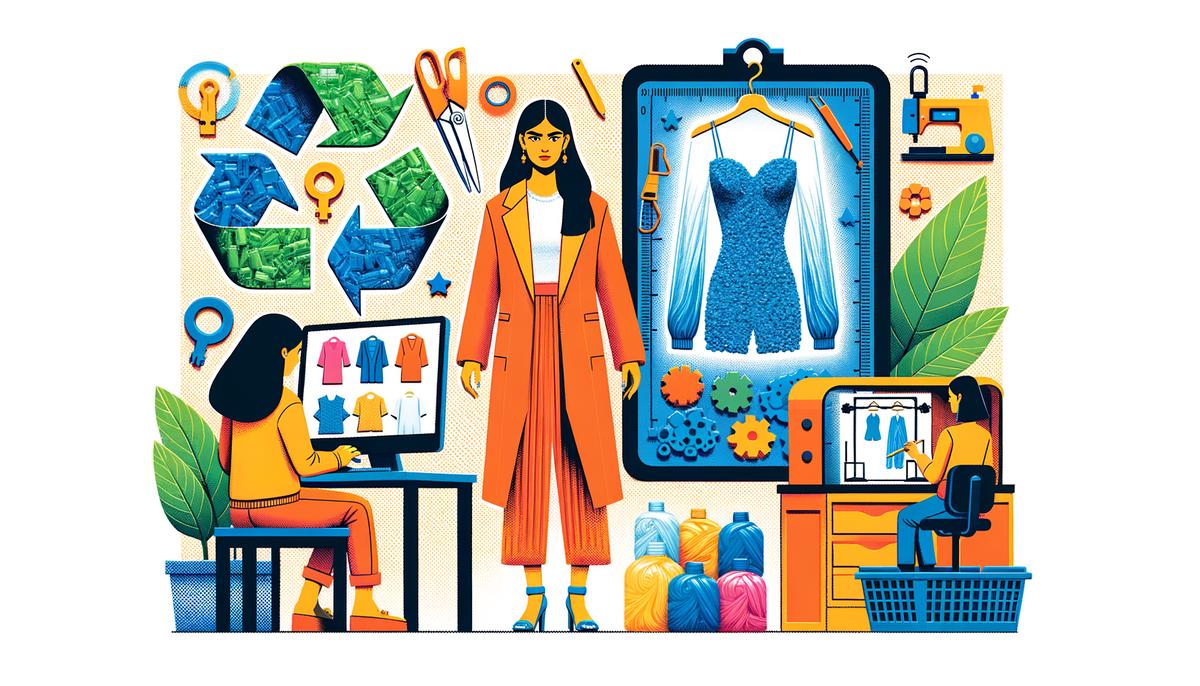Consumer Shift to Sustainable Fashion
The landscape of consumer priorities in fashion is changing. Today's shoppers are opting for garments with minimal environmental footprints. A strong movement towards sustainable fashion illustrates an evolving awareness among consumers about the broader impacts of their buying choices.
Locally sourced materials are in the spotlight, influenced by shoppers who'd rather not contribute to carbon emissions associated with transportation of goods across continents. Ethically upstanding brands gain traction as buyers investigate where and how their clothes are made.
The rising demand for 'slow fashion' cannot be ignored. This is a swing towards timelessly styled and carefully crafted apparel, countering the throw-away culture spawned by fast fashion. Durability, reparability, and classic elegance are big draws for a market keen on quality over quantity.
Retailers face pressure to adapt their offerings, and not just in the form of more sustainable products. Transparency is making the list of priorities for shoppers. Detailed disclosures about supply chains were once niche: not anymore.
Integrating robust sustainability measures requires significant alterations in operational protocols, potentially driving up costs. Yet, this opens prosperous corridors too. Targeting enlightened eras brings room for innovative tools and platforms that aid customers in choosing suitable fits digitally, thus reducing returns, waste, and carbon footprints from transportation.
Paid certificates, like fair-trade and cruelty-free badges, see credibility and appeal rising. Customers align their wallets with their values more than ever before, making badges of ethical assurance essential.
Fashion is in a dedicated relationship with the slow transformation to sustainability as consumer priorities shift more mindfulness about their socio-environmental impact. This not only meets the demand for sustainability but also sets brands apart in a competitive, ever-conscious market.
Innovations in Sustainable Materials
Recycled polyester and organic cotton have become integral threads woven into the fabric of mainstream fashion, redefining the industry's responsibility to society and the environment. Recycled polyester, garnered from discarded plastic bottles, realizes a dual benefit: tidying up earthly landscapes, while providing the textile world solid grounds for creative rendezvous.
Organic cotton, spared from pesticides and synthetic fertilizers, conveys a marked leap reducing harmful environmental impacts. Its cultivation supports natural crop rotation and healthier soil biology, which increases both the quality of water returned to the habitat and the life standards of those tilling the lands.
Innovative materials sparked by pioneering botanical research, like pineapple leather and kelp-derived fabric, are stitching new patterns of possibility across apparel and accessory trends. Pineapple leather offers a cruelty-free alternative that sits well with vegan and eco-conscious minds, flaunting durability alongside desirability. Similarly, textiles derived from seaweed sequester carbon dioxide and return a piece of the ocean's rhythm back into our daily wear.
As these materials interlace more deeply into the domains of high-street and luxury fashion, they marry allure with responsibility. The implications layer wider than just less environmental harm; they predict fashion potential where wastage declines, resources regenerate, and humankind's footprint treads lighter.
Each of these thoughtfully developed materials also presents advantageous business models that encourage closed-loop production cycles—designing in a way that both materials' beginnings and ends are environmentally sensitive. Brands turn increasingly to these cycles, building consumer trust as modern buyers often look behind the label for reassurance that their garments do good.
Amidst applauding these developments, it's equally pivotal to focus on distributing knowledge and accessibility so every fashion seeker can participate meaningfully in this sustainable dialogue. As these sustainable materials weave their way through catwalks and closet staples, they hint at a stylishly savvy future brimming with compassion—a future where fabric choice at boutiques might just reflect a patron's ideals as accurately as their color preferences.

The Role of Technology in Sustainable Fashion
The role of technology in promoting sustainability in futuristic fashion is groundbreaking. Digital wizardry with 3D printing, AI in trend prediction, and virtual fittings are merging to revolutionize the fashion industry by optimizing production processes and personalizing consumer experiences while reducing waste.
3D printing allows designers to conceptualize and create intricate designs without the traditional material waste associated with garment manufacturing. This technology supports new levels of creativity and offers precise production of parts needed without surplus. From buttons to custom textiles, producing only what is necessary speaks directly to the sustainable ideology of reducing environmental impact.
Artificial Intelligence's role in trend forecasting and inventory management is equally transformative. AI algorithms analyze vast amounts of data—consumer preferences, global fashion trends, and purchasing patterns—to predict upcoming trends with higher accuracy. This means less guesswork and overproduction. By producing what is more likely to sell, fashion retailers can avoid the cycle of surplus inventory and seasonal clearances, which often result in discarded clothes that contribute to landfill waste.
Perhaps one of the most customer-focused technologies revolutionizing sustainable fashion are virtual fittings. Virtual fitting rooms use augmented reality (AR) and body scanning technology, allowing consumers to try on clothes virtually from wherever they are. These technologies significantly cut down on the high volume of returns that plague the online shopping world. They ensure a better fit, reducing the likelihood of returns due to size mismatches which minimizes the carbon footprint related with additional shipping and packaging waste.
Such technological integrations are rapidly turning modern fashion into a high-tech affair that harmoniously aligns with sustainability. Brands no longer just design clothes; they orchestrate a tapestry intertwining technology, fashion, and ecological mindfulness. The fusion represents an evolved industry that dazzles with its innovation and commands respect for its committed approach to reducing planetary strain.
As we march forward, these technological innovations hold the promise of transforming passive shoppers into proactive, informed participants of a sustainable fashion revolution. The conjunction of tech and ethics represents a powerful stride toward a fashion future that respects both people and planet—a fashion that costumes us in style, and in conscience too.

Ethical Supply Chains and Transparency
Transparent and ethical supply chains are vitally essential cogs in the burgeoning machine of sustainable fashion. As consumers become more knowledge-savvy and conscientious buyers, they increasingly demand fidelity in the end product and its genesis—the entire narrative from stitching seams to sourcing seeds. The incorporation of ethical procedures across the supply chain reflects a shift safeguarding worker welfare and cementing responsible sourcing measures.
One fundamental aspect where transparency earns its stripes concerns labor practices. Ethical labor practices go beyond mere compliance; they encapsulate:
- Fair wages
- Reasonable hours
- Safe working conditions
- Respect for human rights
Consumers want the clothing they wear to be free of exploitative labor scars. Brands who choose to flaunt their ethical labor practices position themselves on a catwalk tackling good conscience and consumer trust in one stride.
For fashion moguls, the quest for transparency does not stop at comfortable employee quarters. Tied intricately with labor is the sourcing of materials—a vital vector dictating the texture of the very fiber of sustainable fashion. Discerning brands are binding themselves to full disclosure about their sources, scrambling to parade alliances with suppliers who prioritize renewal resources, and counter-standard procedures. Such alliances fortify brands against rising skepticism and bolster claims with bona fide receipts and sustainability metrics.
In this conscious fabric of the ecosystem, consumer trust is paramount and purloined through openness. Labels should become as descriptive as an article and as emotive as prose, unraveling the minimalistic yet pivotal input details. Companies weaving verbose webs of procurement stories around recycled or organic origin elicit charm in the segment, arming purchasers with a backstage pass to the origin tales overlooked in years dusted.
Leveraging digital technology to cast highlight beams across spools of unchecked narratives steers sustainable engagements. QR codes linking apparel to detailed information capsules about life-level impacts and stories of creation convert potential consumers into allies. This digital-bedrock strategy does not merely echo in sales charts but loops sustainability chants underlining ethical sagas attracting minds and investing insight into visceral choices of modern buyers.
From farm-gate to fitting-room, every stage innervates systemic integrity and stitches transparency dreams into the larger fabric deemed vital: a world harmonizing human equity with environmental stewardship. As labels translate wearing apparel into bearing apparel, the bartering writ exchanged between consumer whispers and industry giants nudges closer to equilibrium, culminating in an industry dressed as handsomely inward as it projects outward. Embedding transparency is not just a seam to adorn—it's the very thread keeping the indispensable quilt of ethical fashion intact and vibrant.
- Niinimäki K, Peters G, Dahlbo H, et al. The environmental price of fast fashion. Nat Rev Earth Environ. 2020;1(4):189-200.
- Ellen MacArthur Foundation. A New Textiles Economy: Redesigning Fashion's Future. 2017.
- Global Fashion Agenda. 2020 Circular Fashion System Commitment. 2020.










